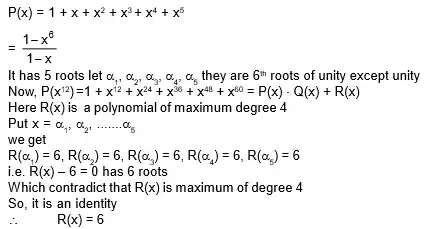Let $P(x) = 1 + x + x^2 + x^3+ x^4 + x^5$. What is the remainder when $P(x^{12})$ is divided by $P(x)$?
(a) $0$
(b) $6$
(c) $1+x$
(d) $1 + x + x^2 + x^3+ x^4 $
The way I adopted to solve this question was by putting x=1 which gives remainder= $0$ and this matches with option (a). But the answer to this question is 6. I am not able to understand the solution given:

It would be great if someone could explain the solution in simpler or more intuitive terms. Another way of solving the question is also welcome.